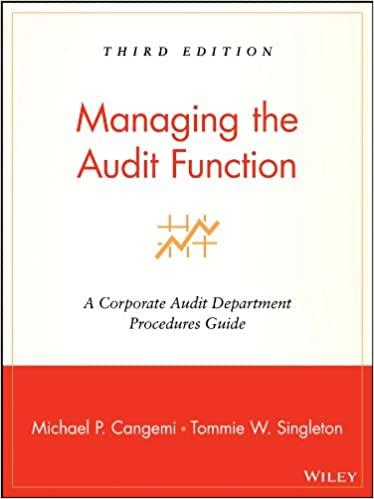Question
QUESTION 4 Which of the following is the most favorable as a choice for the beneficiary of a qualified plan participant if stretching benefits is
QUESTION 4
Which of the following is the most favorable as a choice for the beneficiary of a qualified plan participant if stretching benefits is desired?
| A. | The participant's healthy adult son | |
| B. | A friend who is 11 years younger | |
| C. | The participant's spouse | |
| D. | The participants estate |
QUESTION 5
On December 31 of last year, Samuel Herman had $360,000 in his IRA. He has named Trudy Herman, his wife, as beneficiary. He wants you to determine the amount he must withdraw for his RMD this year and the date by which the withdrawal must be made. This year, he turned age 72 on October 17, and Trudy turned age 35 on January 8. (Assume the IRS RMD Joint Life Table divisor for two individuals ages 72 and 35 is 47.5; ages 73 and 36 is 46.6, and ages 74 and 37 is 45.6. The IRS Table I divisor for an individual age 72 is 15.5, age 73 is 14.7, and age 74 is 14.1. The Uniform Table factor is 27.4 at age 72 and 26.5 at age 73.)
What is the smallest required minimum distribution (RMD) that Samuel can take, and when must distributions begin?
| A. | He must begin distributions on April 1 of this year in the amount of $13,139. | |
| B. | He must begin distributions on April 1 of next year in the amount of $7,579. | |
| C. | He must begin distributions on April 1 of next year in the amount of $14,063. | |
| D. | He must begin distributions on April 1 of next year in the amount of $8,072. |
QUESTION 6
In the calculation of required minimum distributions (RMDs) from an IRA or qualified plan, which of these is assumed in the application of the Uniform Lifetime Table (Table III)?
| A. | The Uniform Lifetime Table is designed to liquidate the participant's account over a single average life expectancy. | |
| B. | The divisor amounts appearing in the Uniform Lifetime Table are calculated on the assumption that every retired taxpayer has a beneficiary who is 10 years younger, regardless of the actual age of any beneficiary. | |
| C. | The life expectancy used from the Uniform Lifetime Table for the first RMD is the age of the participant as of April 1 of the year in which the participant attains age 72. | |
| D. | The table may not be used if the beneficiary of the participant is not a spouse. |
Step by Step Solution
There are 3 Steps involved in it
Step: 1

Get Instant Access to Expert-Tailored Solutions
See step-by-step solutions with expert insights and AI powered tools for academic success
Step: 2

Step: 3

Ace Your Homework with AI
Get the answers you need in no time with our AI-driven, step-by-step assistance
Get Started


